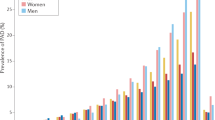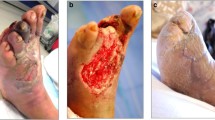Abstract
Pharmacotherapeutic Strategies in Peripheral Arterial Occlusive Disease
Peripheral arterial disease of the lower limbs is a manifestation of atherosclerosis, and may also affect other vascular territories such as the coronary and cerebral arteries. Progressive narrowing of the vessels up to total occlusion can present as intermittent claudication or pain at rest, with or without cutaneous lesions. Patients with intermittent claudication are at a low risk of amputation, and the symptom has to be regarded as a warning signal for myocardial infarction and stroke. Nevertheless, if the patient’s walking distance is too limited to allow a near-normal life, symptomatic treatment to improve quality of life should be considered. Treatment may consist of walking exercise, surgical or interventional radiological revascularisation, or, in some cases, administration of vasoactive drugs. Antiplatelet agents should be administered in an attempt to limit disease progression and prevent cardiac and cerebrovascular complications, together with active measures to reduce established risk factors such as smoking, diabetes, hyperlipidaemia, and arterial hypertension.
The presence of pain at rest indicates that a lower limb is jeopardised, especially when the criteria for critical ischaemia have also been met. These criteria include the presence of chronic (lasting for more than 2 weeks) symptoms of ischaemia at rest and a systolic blood pressure less than 50mm Hg or 30mm Hg at the ankle or big toe, respectively. In such a situation, revascularisation should be attempted whenever possible. If this is not possible or if the procedure has failed, prostacyclin administered intravenously for days or weeks is an alternative. After revascularisation, early reocclusion may be prevented by administering anticoagulants and late reocclusion by antiplatelet agents, in conjunction with eradication of risk factors.
In all situations, therapeutic decision-making should be undertaken in a multidisciplinary setting and should include the following: specialists in angiology (an internist) and interventional radiology; a vascular surgeon; an orthopaedic surgeon, if necessary; and diabetes and infectious disease specialists.
Résumé
L’artériopathie oblitérante des membres inférieurs n’est qu’une manifestation d’une maladie athérothrombotique plus généralisée, qui affecte également les territoires coronaires et cérébrovasculaires. Elle peut se manifester par une claudication intermittente ou des symptômes de repos. Dans le premier cas, le traitement visera à atténuer ou supprimer les symptômes (exercices de marche, revascularisation radiologique ou chirurgicale, parfois agents vasoactifs) et à retarder la progression de la maladie (éradication des facteurs de risque). Dans le deuxième cas, le membre inférieur est menacé et les mesures de revascularisation devront toujours être envisagées, l’administration parentérale de prostaglandines ne devant être proposée qu’en cas d’échec ou d’impossibilité de revascularisation. Après revascularisation, des mesures de prévention de l’occlusion précoce ou tardive devront être associées à la lutte contre les facteurs de risque. Dans tous les cas, les décisions thérapeutiques devraient faire l’objet d’un consensus multidisciplinaire associant angiologue, radiologue interventionnel, chirurgien vasculaire et, selon les circonstances, chirurgien orthopédiste, diabétologue et infectiologue.
Similar content being viewed by others
Références
Kannel WB, Wolf PA, Castelli WP, et al. Fibrinogen and risk of cardiovascular disease. JAMA 1987; 258: 1183–6
Rader DJ, Brewer HB. Lipoprotein (a). Clinical approach to a unique atherogenic lipoprotein. JAMA 1992; 267: 1109–12
Fowkes FGR, Lowe GDO, Housley E, et al. Cross-linked fibrin degradation products, progression of peripheral arterial disease, and risk of coronary heart disease. Lancet 1993; 342: 84–6
Clarke R, Daly L, Robinson K, et al. Hyperhomocysteinemia: an independent risk factor for vascular disease. N Engl J Med 1991; 324: 1149–55
van der Schouw Y, van der Graaf Y, Steyerberg EW, et al. Age at menopause as a risk factor for cardiovascular mortality. Lancet 1996; 347: 714–8
Kannel WB, McGee DL. Update on some epidemiologic features in intermittent claudication: the Framingham Study. J Am Geriatr Soc 1985; 33: 13–8
European Working Group on Critical Leg Ischemia. Second European consensus document on chronic critical leg ischemia. Circulation 1991; 84 Suppl. IV: 1–26
Juergens JL, Barker NW, Hines Jr EA. Arteriosclerosis obliterans: review of 520 cases with special reference to pathogenic and prognostic factors. Circulation 1960; 21: 188–95
Dormandy JA, Mahir M, Ascady G, et al. Fate of the patient with chronic limb ischemia. J Cardiovasc Surg 1989; 30: 50–7
Criqui MH, Langer RD, Fronek A, et al. Mortality over a period of 10 years in patients with peripheral arterial disease. N Engl J Med 1992; 326: 381–6
Quick CRG, Cotton LT. The measured effect of stopping smoking on intermittent claudication. Br J Surg 1982; 69 Suppl.: S24–6
Gardner AW, Poehlman ET. Exercise rehabilitation programs for the treatment of claudication pain. Ameta-analysis. JAMA 1995; 274: 975–80
Verhaeghe R, Bounameaux H. Peripheral arterial occlusion: thromboembolism and antithrombotic therapy. In: Verstraete M, Fuster V, Topol EJ, editors. 2nd ed. Cardiovascular thrombosis. Philadelphia: Lippincott-Raven Press, 1998: 631–55
Hunink MGM, Wong JB, Donaldson MC, et al. Revascularization for femoropopliteal disease. JAMA 1995; 274: 165–71
Boissel JP, Peyrieux JC, Destors JM. Is it possible to reduce the risk of cardiovascular events in subjects suffering from intermittent claudication of the lower limbs? Thromb Haemost 1989; 62: 681–5
Branchereau A, Rouffy J. Essai comparatif randomisé en double aveugle du tartrate d’ifenprodil dans l’artériopathie oblitérante chronique des membres inférieurs au stade II de la classification de Leriche et Fontaine. J Mal Vasc 1995; 20: 21–7
Antiplatelet Trialists’ Collaboration. Collaborative overview of randomised trials of antiplatelet therapy — I: Prevention of death, myocardial infarction, and stroke by prolonged anti-platelet therapy in various categories of patients. BMJ 1994; 308: 81–106
Clagett PG, Krupski WC. Antithrombotic therapy in peripheral arterial occlusive disease. Chest 1995; 108: 431S–443S
Pecquemin JP. Effect of ticlopidine on the long-term patency of saphenous-vein by-pass grafts in the legs. N Engl J Med 1997; 337: 1726–31
Kretschmer G, Herbst F, Prager M, et al. A decade of oral anticoagulant treatment to maintain autologous vein grafts for femoropopliteal atherosclerosis. Arch Surg 1992; 127: 1112–5
Second European Consensus Document on Chronic Critical Leg Ischemia. Circulation 1991; 84 Suppl. IV: 15–7
Ismer JM, Pieczek A, Schainfeld R, et al. Clinical evidence of angiogenesis after arterial gene transfer of ph VEGF 165 in patients with ischaemic limb. Lancet 1996; 348: 370–4
Author information
Authors and Affiliations
Corresponding author
Rights and permissions
About this article
Cite this article
Bounameaux, H., Wütschert, R. Prise en charge médicale de l’artériopathie des membres inférieurs. Drugs 56 (Suppl 3), 17–23 (1998). https://doi.org/10.2165/00003495-199856003-00003
Published:
Issue Date:
DOI: https://doi.org/10.2165/00003495-199856003-00003




